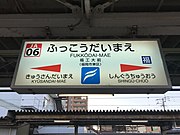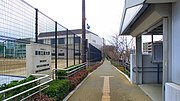Fukkōdai-mae Station
 Fukkōdai-mae Station in 2010 | |||||||||||
| General information | |||||||||||
| Location | 1-chōme-22 Wajirogaoka, Higashi-ku, Fukuoka-shi, Fukuoka-ken, 811-021 Japan | ||||||||||
| Coordinates | 33°41′56″N 130°26′27″E / 33.6989°N 130.4408°E | ||||||||||
| Operated by | |||||||||||
| Line(s) | JA Kagoshima Main Line | ||||||||||
| Distance | 65.1 km from Mojikō | ||||||||||
| Platforms | 2 island platforms | ||||||||||
| Tracks | 4 | ||||||||||
| Construction | |||||||||||
| Structure type | Elevated | ||||||||||
| Other information | |||||||||||
| Website | Official website | ||||||||||
| History | |||||||||||
| Opened | 1 June 1915 | ||||||||||
| Previous names | Chikuzen Shingũ (to 2008) | ||||||||||
| Passengers | |||||||||||
| FY2020 | 8,273 | ||||||||||
| Rank | 12th | ||||||||||
| Services | |||||||||||
| |||||||||||
| Location | |||||||||||
 | |||||||||||
Fukkōdai-mae Station Station (福工大前駅, Fukkōdaimae-eki) is a passenger railway station located in Higashi-ku, Fukuoka Prefecture, Japan.[1]
Lines[edit]
The station is served by the Kagoshima Main Line and is located 65.1 km from the starting point of the line at Mojikō.[2]
Layout[edit]
The station consists of two island platforms serving four tracks, connected by an elevated station building. The station has a Midori no Madoguchi staffed ticket office. There are two entrances, the north exit where the station building is located, and the Fukuko Oguchi exit, which are connected by a free passage; however, Fukuko Oguchi is a passageway for people affiliated with the Fukuoka Institute of Technology, and is prohibited to anyone other than those affiliated with it (as this passageway is located within the school grounds)[2]
Platforms[edit]
| 1 | ■ JA Kagoshima Main Line | for Orio and Kokura |
| 2 | ■ JA Kagoshima Main Line | for Kurume, Tosu and Hakata |
-
Concourse
-
Platforms
-
Station sign
-
Fukuko Oguchi exit
History[edit]
Japanese Government Railways (JGR) opened Shingū Signal Box (新官(信号所), Shingū shingosho) on 1 June 1915. On 1 October 1920 it was upgraded to a passenger station and its name was changed to Chikuzen Shingũ Station (筑前新官駅) and its location was shifted 100 metres further to the south on the line. Previously, the station building and platform spanned Higashi Ward in Fukuoka and Shingu Town, but after reconstruction in 1987, both the station building and the platform are entirely within Higashi Ward. With the privatization of Japanese National Railways (JNR), the successor of JGR, on 1 April 1987, JR Kyushu took over control of the station.[3][4] The station was renamed Fukkōdai-mae on 15 March 2008. The name means, literally, "in front of the Fukuoka Institute of Technology".
Passenger statistics[edit]
In fiscal 2020, the station was used by an average of 8,273 passengers daily (boarding passengers only), and it ranked 12th among the busiest stations of JR Kyushu.[5]
Surrounding area[edit]
- Fukuoka Institute of Technology
- Fukuoka Institute of Technology Joto High School
- Shingu town center
See also[edit]
References[edit]
- ^ "JR Kyushu Route Map" (PDF). JR Kyushu. Retrieved 23 February 2018.
- ^ a b Kawashima, Ryōzō (2013). 図説: 日本の鉄道 四国・九州ライン 全線・全駅・全配線・第3巻 北九州 筑豊 エリア [Japan Railways Illustrated. Shikoku and Kyushu. All lines, all stations, all track layouts. Volume 3 Kyushu Chikuhō area] (in Japanese). Kodansha. pp. 25, 68. ISBN 9784062951623.
- ^ Ishino, Tetsu; et al., eds. (1998). 停車場変遷大事典 国鉄・JR編 [Station Transition Directory – JNR/JR] (in Japanese). Vol. I. Tokyo: JTB Corporation. p. 218. ISBN 4-533-02980-9.
- ^ Ishino, Tetsu; et al., eds. (1998). 停車場変遷大事典 国鉄・JR編 [Station Transition Directory – JNR/JR] (in Japanese). Vol. II. Tokyo: JTB Corporation. pp. 677–8. ISBN 4-533-02980-9.
- ^ "駅別乗車人員上位300駅(2020年度)" (PDF). Retrieved 8 September 2023.
External links[edit]
![]() Media related to Fukkodaimae Station at Wikimedia Commons
Media related to Fukkodaimae Station at Wikimedia Commons
- Fukkōdai-mae (JR Kyushu)(in Japanese)






